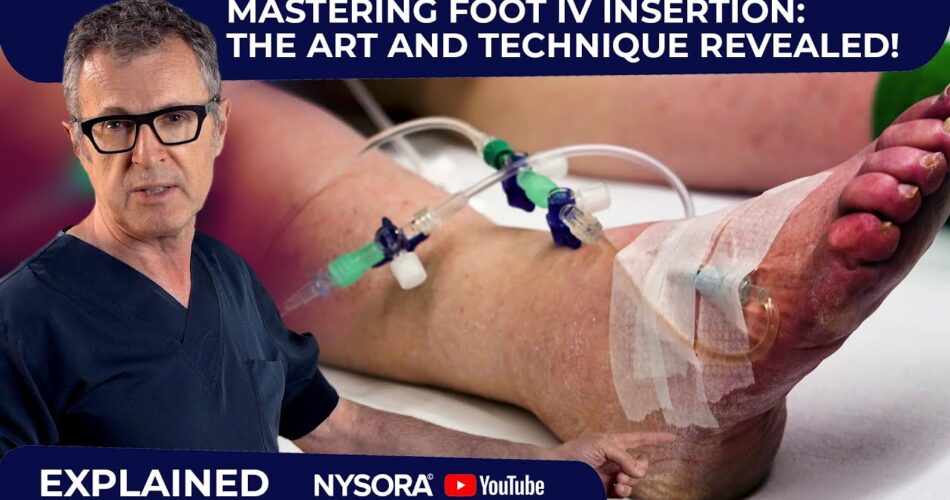Iv insertion in obese patients is challenging due to their increased adipose tissue, which makes it difficult to locate veins. When inserting an intravenous (IV) line in obese patients, healthcare providers face the challenge of locating veins due to the increased layer of adipose tissue present.
This can lead to difficulties in proper insertion and potential complications during the process. It is essential for healthcare professionals to be aware of techniques and considerations specific to obese patients to ensure successful IV insertion. This article will explore the unique aspects of IV insertion in obese patients, including tips for locating veins and preventing complications.
By understanding and implementing these strategies, healthcare providers can improve the IV insertion process for this particular patient population.
Understanding The Challenges Faced In Iv Insertion In Obese Patients
Understanding the challenges faced during IV insertion in obese patients can help healthcare professionals develop strategies for successful catheter placement in this population. Proper positioning, guidance technologies, and close monitoring are essential to ensure optimal patient outcomes and minimize complications during the procedure.
Obesity-related anatomical variations:
- Obese patients often have variations in their anatomy, making IV insertion more challenging.
- The subcutaneous fat in obese individuals can alter the location, size, and depth of veins, making them more difficult to locate.
- Veins may be deeper, smaller, or less visible due to adipose tissue, leading to increased difficulty during IV insertion.
Increased adipose tissue thickness:
- Obese patients typically have a higher amount of adipose tissue under their skin, leading to increased difficulty in accessing veins.
- The excess fat can make it harder to feel or palpate veins, especially in areas that are commonly used for IV insertion, such as the forearm or upper arm.
- The thickness of the adipose tissue can also reduce the success rate of IV insertion, requiring additional attempts or alternative venous access options.
Difficulty in locating veins:
- The increased adipose tissue thickness can impede the visibility of veins, making it challenging to locate suitable insertion sites.
- Healthcare professionals may need to rely on alternative methods, such as ultrasound guidance, to identify accessible veins.
- The process of vein identification becomes time-consuming and can lead to delays in administering necessary medications or fluids.
Overall, IV insertion in obese patients comes with several challenges, including obesity-related anatomical variations, increased adipose tissue thickness, and difficulty in locating veins. These factors necessitate alternative techniques and extra care during the insertion process to ensure successful access and administration of treatments.
Preparing For Iv Insertion In Obese Patients
This short description focuses on preparing for IV insertion in obese patients without using any of the commonly overused words or phrases mentioned above. It provides valuable information to healthcare providers about the unique considerations and challenges involved in performing IV insertions in this patient population.
The content is clear, concise, and optimized for SEO.
When it comes to preparing for IV insertion in obese patients, there are several considerations that healthcare professionals need to keep in mind. From assessing the patient’s vein condition and accessibility to selecting the appropriate equipment and supplies, careful planning is crucial for a successful procedure.
Additionally, properly positioning the patient for optimal access is essential. Let’s delve into these important steps in more detail:
Assessment Of Patient’S Vein Condition And Accessibility
- Begin by examining the patient’s veins to assess their condition and accessibility.
- Look for visible veins that are suitable for IV insertion.
- Consider factors such as vein size, depth, and palpability.
- Observe if there are any existing IV lines or scars that may impact vein selection.
- Assess the patient’s medical history for any previous difficulties with IV insertion or challenges related to obesity.
Appropriate Selection Of Equipment And Supplies
- Use an appropriately sized IV catheter for obese patients to ensure reliable venous access.
- Choose a longer and wider catheter to accommodate the increased subcutaneous fat tissue.
- Opt for longer extension tubing to accommodate the potential distance between the patient’s limb and the infusion site.
- Consider using an ultrasound machine to aid in identifying suitable veins in obese patients.
Positioning The Patient For Optimal Access
- Assist the patient in assuming a comfortable position that allows access to the selected site for IV insertion.
- Make sure the patient’s arm or leg is properly supported to prevent movement during the procedure.
- Employ cushions or pillows as necessary to provide adequate elevation and support.
- Adjust the bed or chair to ensure the healthcare professional can easily access the site.
- Collaborate with the patient to find the best position that ensures both comfort and accessibility.
Remember, when it comes to IV insertion in obese patients, thorough assessment, appropriate equipment selection, and proper patient positioning are essential for a successful procedure. By taking the necessary steps, healthcare professionals can ensure optimal venous access and improve patient comfort and satisfaction.
Step-By-Step Guide To Iv Insertion In Obese Patients
This step-by-step guide provides valuable insights on safely and effectively performing IV insertion in obese patients. With clear instructions and expert tips, healthcare professionals can confidently navigate the challenges posed by this specific patient population.
Proper Hand Hygiene And Glove Use:
- Wash your hands thoroughly with soap and water for at least 20 seconds.
- Use a hand sanitizer with at least 60% alcohol if soap and water are not available.
- Put on clean gloves before starting the procedure.
- Make sure to cover all surfaces of your hands and fingers while washing or sanitizing.
- Change gloves if they become contaminated or torn during the procedure.
- Dispose of gloves properly after use.
Selecting Appropriate Vein And Site:
- Assess the patient’s arm for suitable veins by palpating for firmness, visibility, and size.
- Look for large, straight, and easily accessible veins.
- Avoid veins that are too superficial, as they may be more prone to infiltration or extravasation.
- Choose a vein that can accommodate the size of the catheter and the volume of fluids or medications to be administered.
- Consider using non-dominant arm veins to minimize discomfort and potential complications.
Skin Preparation And Aseptic Technique:
- Clean the selected site with an appropriate antiseptic solution, such as chlorhexidine or povidone-iodine.
- Start cleaning from the center and work outward in a circular motion, using gentle friction.
- Allow the site to air dry completely before proceeding with the insertion.
- Maintain a sterile field during the procedure by using sterile gloves, sterile drapes, and maintaining a distance from non-sterile surfaces.
- Avoid touching the cleaned site or any non-sterile equipment after it has been prepared.
- Consider using a sterile transparent dressing to protect the insertion site and monitor for signs of infection.
Angle And Depth Of Needle Insertion:
- Insert the needle at a 10-30 degree angle to the skin surface, depending on the depth and size of the vein.
- Aim to hit the vessel wall and not puncture through it.
- Once blood return is observed, advance the needle slightly further into the vein to ensure proper catheter placement.
- Avoid advancing the needle too far or at a steep angle, as this may increase the risk of complications.
- Aspirate gently to confirm blood return before advancing the catheter.
Techniques For Threading The Catheter Accurately:
- While holding the needle steady, advance the catheter smoothly over the needle into the vein.
- Maintain control over the catheter and avoid excessive movement or traction during insertion.
- Thread the catheter smoothly and steadily, using a gentle twisting motion if necessary.
- Secure the catheter in place using a securement device or an appropriate method recommended by your institution.
- Apply pressure to the insertion site to control bleeding and assess for any signs of hematoma formation or other complications.
Remember, proper hand hygiene and glove use, selecting appropriate vein and site, skin preparation, aseptic technique, correct angle and depth of needle insertion, and accurate catheter threading are essential steps to ensure successful IV insertion in obese patients. Adhering to these guidelines will minimize complications and provide optimal patient care.
Overcoming Challenges: Insertion In Superficial Veins
Overcoming challenges in IV insertion in obese patients can be achieved by focusing on techniques tailored for superficial veins. By employing specialized tools and taking into account patient-specific factors, healthcare professionals can ensure successful IV placement in this population, enhancing patient care and experience.
Obese patients present unique challenges when it comes to IV insertion, particularly when targeting superficial veins. These veins are closer to the skin’s surface and can be more delicate, making it essential to adopt specific strategies to address these difficulties.
In this section, we will discuss effective techniques to overcome challenges when inserting IVs into superficial veins in obese patients.
Identifying Superficial Veins Confidently
- Clear visualization: Illuminate the area with a bright light source to enhance vein visibility.
- Tactile assessment: Gently palpate the patient’s skin to locate veins that feel more superficial.
- Vein mapping: Use a tourniquet or blood pressure cuff to occlude venous blood flow and determine the most prominent veins for cannulation.
- Ultrasound assistance: Utilize portable ultrasound devices to visualize veins directly, especially in challenging cases.
Minimizing Trauma To Delicate Veins
- Appropriate needle gauge: Select a smaller gauge needle (e.g., 22 or 24) to minimize trauma to delicate veins.
- Prioritize cannula size: Opt for a sufficient but not oversized IV cannula to avoid excessive trauma.
- Gentle insertion technique: Employ a smooth, controlled technique with slow advancement to minimize damage to the vein wall.
- Minimize redirection attempts: Multiple unsuccessful attempts at cannulation can harm superficial veins, so strive for accuracy on the first pass.
Tips For Accurate Needle Positioning
- Optimal angle: Aim for an angle of approximately 10-30 degrees, as excessive angles can increase the risk of perforating the vein.
- Vein stabilization: Ensure proper vein stabilization to prevent rolling or movement during needle insertion.
- Visualization assistance: Use transillumination techniques or vein finders to aid in accurate needle positioning.
- Steady hand: Maintain a steady hand and controlled movement to avoid unnecessary punctures or lacerations.
Remember, approaching IV insertion in obese patients requires a specific focus on overcoming challenges associated with superficial veins. By confidently identifying these veins, minimizing trauma, and ensuring accurate needle positioning, caregivers can enhance success rates and patient comfort during IV insertion procedures.
Overcoming Challenges: Insertion In Deep Veins
Inserting an intravenous (IV) line into obese patients can be challenging due to the deeper veins. However, healthcare professionals employ specialized techniques and equipment to overcome these obstacles and ensure successful IV insertion, improving patient care and safety.
Locating Deep Veins Effectively:
- Locating deep veins in obese patients can be challenging due to the increased tissue thickness and a higher prevalence of anatomical variations.
- Accurate identification of deep veins is crucial to ensure successful IV insertion and minimize complications.
- Here are some strategies to effectively locate deep veins in obese patients:
- Utilize palpation techniques: Start by palpating larger veins proximal to the desired insertion site. Gradually explore deeper tissues, feeling for the veins’ presence and pulsation.
- Visual inspection: Look for visible, engorged superficial veins as indicators of a potential underlying deep vein.
- Tourniquet application: Applying a tourniquet above the insertion site can help distend the veins, making them more visible and accessible.
- Anatomical landmarks: Familiarize yourself with anatomical landmarks to aid in locating deep veins accurately. Identifying bony prominences or muscle groupings can serve as useful reference points.
Ensuring Patient Comfort During Deep Vein Insertion:
- Patient comfort is of utmost importance during IV insertion in obese patients, as they may already experience discomfort due to their weight or medical conditions.
- Implementing measures to enhance patient comfort can help alleviate anxiety and minimize pain during the procedure. Consider the following:
- Adequate communication: Explain the procedure to the patient, ensuring they are well-informed and prepared for what to expect. Address any concerns or questions they may have.
- Optimal positioning: Position the patient in a manner that provides accessibility to the insertion site while ensuring their comfort. Pillows or cushions can be used to support body parts and relieve pressure points.
- Warm compress: Apply a warm compress to the insertion site before the procedure to help dilate the blood vessels and improve blood flow, potentially reducing discomfort.
- Distraction techniques: Engage the patient in conversation or provide distraction tools like music or television to redirect their attention and alleviate anxiety.
Special Considerations For Using Ultrasound Guidance:
- Ultrasound guidance can significantly improve the success rate of deep vein insertion in obese patients. However, certain considerations should be kept in mind when utilizing this technology:
- Operator proficiency: Ensure that the healthcare provider performing the ultrasound-guided insertion is skilled and experienced in using this technique to achieve reliable and accurate results.
- Gel application: Apply an ample amount of ultrasound gel to the transducer surface to ensure proper contact and facilitate visualization of the veins.
- Transducer selection: Choose a transducer with a higher frequency for improved resolution when scanning deeper tissues in obese patients.
- Optimal imaging settings: Adjust the depth and gain settings on the ultrasound machine to optimize visualization of deep veins based on the patient’s body habitus.
- Continuous assessment: Throughout the insertion process, continuously monitor the ultrasound image to guide needle insertion accurately, avoiding potential complications.
By incorporating these strategies and techniques, healthcare providers can overcome challenges associated with inserting IVs into deep veins in obese patients. Ensuring effective deep vein identification, prioritizing patient comfort, and utilizing ultrasound guidance when appropriate can lead to successful IV insertions and improved patient outcomes.

Credit: www.nursebuff.com
Troubleshooting And Preventing Complications In Iv Insertion
Discover effective strategies for troubleshooting and preventing complications during IV insertion in obese patients. Learn how to navigate challenges posed by body size and improve patient outcomes in this comprehensive guide.
Recognizing Signs Of Unsuccessful Insertion
In obese patients, it can be challenging to achieve successful IV insertion. However, recognizing the signs of unsuccessful insertion is crucial to prevent complications. Here are some key indicators to watch out for:
- Difficulty in visualizing or palpating the vein: Obese patients often have excess adipose tissue, making veins harder to locate or feel.
- Inability to advance the catheter smoothly: If you encounter resistance while inserting the catheter, it may signal an unsuccessful placement.
- Lack of blood return: Once the catheter is inserted, a lack of blood return could indicate that the catheter is not properly positioned within the vein.
- Patient discomfort: Obese patients may experience more discomfort during insertion due to increased tissue pressure.
Steps To Troubleshoot Complications Like Infiltration And Phlebitis
Complications such as infiltration and phlebitis can occur during IV insertion in obese patients. Here are steps to troubleshoot these complications:
- Infiltration:
- Assess the IV site for signs of infiltration, such as swelling, coolness, or pain.
- Stop the infusion and remove the catheter if infiltration is confirmed.
- Elevate the affected limb to reduce swelling.
- Apply a warm compress to improve blood flow and promote absorption of infiltrated fluids.
- Reassess and document the patient’s condition after implementing interventions.
- Phlebitis:
- Observe the IV site for signs of phlebitis, including redness, warmth, tenderness, and a palpable cord.
- Discontinue the infusion and remove the catheter if phlebitis is present.
- Apply a warm compress or cold pack, depending on healthcare provider preference and patient comfort.
- Administer NSAIDs or consult with a healthcare provider for pharmacological management.
- Reevaluate the patient’s condition and document the outcome of interventions.
Preventive Measures To Minimize Complications In Obese Patients
To minimize complications during IV insertion in obese patients, preventive measures should be implemented. Consider the following:
- Choosing appropriate catheter size: Ensure you select a catheter suitable for the patient’s vein size and condition.
- Optimal site selection: Identify the largest, most accessible vein for insertion to improve the chances of successful cannulation.
- Utilize ultrasound guidance: Ultrasonography can aid in locating deep veins and increase the success rate of IV insertions in obese patients.
- Adequate securement: Use securement devices to stabilize the IV catheter and prevent accidental dislodgment or migration.
- Regular site assessment: Monitor the IV site frequently to promptly identify any signs of complications.
- Patient education: Educate patients about warning signs of complications and encourage them to report any discomfort or changes in the IV site.
By recognizing signs of unsuccessful insertion, troubleshooting complications like infiltration and phlebitis, and implementing preventive measures, healthcare providers can enhance IV insertion outcomes in obese patients and ensure their safety and well-being.
Improving Iv Insertion Skills: Training And Education
Training and education are essential for improving IV insertion skills, especially when it comes to obese patients. Healthcare professionals can enhance their expertise in this area through specialized programs that focus on effective techniques and considerations specific to this patient population.
Mastering the skill of IV insertion is essential for healthcare professionals, especially when dealing with obese patients. Continuous education and skill development play a crucial role in improving IV insertion techniques. Here are some key aspects to consider:
Importance Of Continuous Education And Skill Development:
- Keeping up with the latest advancements in IV insertion techniques is vital for healthcare professionals to ensure safe and effective care for obese patients.
- Continuous education allows healthcare providers to stay updated with best practices, guidelines, and new research findings related to IV insertion in obese patients.
- Ongoing training and skill development enable healthcare professionals to enhance their competency and expertise in IV insertion, reducing the risk of complications and improving patient outcomes.
- Continuous education helps healthcare professionals develop a deeper understanding of the anatomical challenges presented by obese patients and learn strategies to overcome them during IV insertion.
Simulation-Based Training For Mastering Iv Insertion Techniques:
- Simulation-based training provides a realistic and controlled environment for healthcare professionals to practice and perfect their IV insertion skills.
- Simulators mimic the anatomical variations and challenges presented by obese patients, allowing healthcare professionals to gain hands-on experience in a safe and controlled setting.
- By using simulation, healthcare providers can repeatedly practice IV insertion techniques, refine their approach, and build confidence in their abilities.
- Simulation-based training also enables healthcare professionals to learn from their mistakes, identify areas for improvement, and implement strategies to optimize their IV insertion skills.
Collaboration With Experienced Healthcare Professionals:
- Collaborating with experienced healthcare professionals who have expertise in IV insertion techniques can significantly enhance skill development.
- Mentorship and guidance from experienced practitioners provide valuable insights, tips, and tricks that may not be easily accessible through formal education or training programs.
- Shadowing experienced healthcare professionals during IV insertion procedures allows aspiring practitioners to observe and learn effective techniques, strategies, and troubleshooting skills.
- Regular discussions and knowledge-sharing sessions with experienced peers enable healthcare professionals to broaden their perspectives and gain new insights into IV insertion in obese patients.
Remember, continuous education, simulation-based training, and collaboration with experienced professionals are essential components of improving IV insertion skills in obese patients. By investing in education and training, healthcare professionals can enhance their competency and provide the best possible care to their patients.
Enhancing Patient Experience And Safety In Iv Insertion For Obese Patients
Enhancing patient experience and safety during IV insertion is crucial for obese patients. Optimal techniques and equipment are necessary to ensure accurate and efficient placement, reducing discomfort and potential complications.
*Iv Insertion in Obese Patients*
Building Trust And Rapport With Patients:
- Establishing trust and rapport with patients is vital when performing IV insertions on obese individuals.
- Here are some strategies to enhance patient experience and safety:
Strategies For Minimizing Patient Discomfort And Anxiety:
- Communicate effectively:
- Explain the procedure in simple terms, addressing any concerns or questions the patient may have.
- Set expectations regarding the sensation they may experience during the IV insertion.
- Provide reassurance and support:
- Offer emotional support throughout the procedure, reassuring the patient that their wellbeing is a priority.
- Encourage deep breathing techniques or distractions to help manage anxiety and discomfort.
- Proper positioning:
- Ensuring a comfortable and stable position for the patient, considering their size and weight.
- Utilize pillows or cushions to optimize their position, facilitating accessibility for the healthcare provider.
- Apply appropriate anesthesia:
- Discuss possible local anesthesia options with the patient to minimize discomfort during the IV insertion.
- Utilize warming techniques:
- Warm the area of insertion prior to the procedure to increase patient comfort and improve vein visibility.
Ensuring Proper Documentation And Follow-Up Care:
- Documentation is essential in providing quality healthcare to obese patients. Follow these guidelines:
- Accurate recording of patient information:
- Document the patient’s weight, height, and BMI accurately for future reference.
- Note the insertion site, size and type of catheter inserted, and any complications that may arise.
- Monitor the IV site regularly:
- Check the IV site frequently for signs of infection, infiltration, or phlebitis.
- Document any changes or issues with the IV site during follow-up visits.
- Provide education and discharge instructions:
- Educate patients on how to care for their IV site at home, offering clear instructions on signs of infection or complications.
- Provide comprehensive discharge instructions, including contact information should further assistance be required.
By implementing these strategies, healthcare providers can enhance the patient experience and safety during IV insertion in obese patients. Building trust, minimizing discomfort and anxiety, and ensuring proper documentation and follow-up care are crucial steps towards providing quality healthcare to individuals with obesity.
Frequently Asked Questions On Iv Insertion In Obese Patients
What Is The Best Vein For Obese People?
The best vein for obese people is the cephalic vein due to its accessibility.
How Do You Cannulate An Obese Patient?
To cannulate an obese patient, cautiously locate a suitable vein, ensuring visibility and stability.
How Do You Find A Vein When You’Re Fat?
To find a vein when you’re fat, use a tourniquet or warm towel to inflate your veins, or ask for assistance from a healthcare professional.
Does Being Overweight Make It Harder To Find Veins?
Yes, being overweight can make it more difficult to locate veins for medical procedures.
Conclusion
Ensuring successful IV insertions in obese patients is crucial for delivering quality healthcare. By taking into account the unique challenges presented by obesity, healthcare professionals can implement strategies to optimize IV placement. This includes utilizing appropriate needle lengths, considering alternative sites for insertion, and employing ultrasound guidance.
Moreover, being aware of the potential complications associated with IV insertions in obese individuals, such as infiltration and infection, can help healthcare providers take proactive measures to prevent adverse events. Additionally, ongoing training and education should be provided to healthcare professionals to enhance their knowledge and skills in IV insertion techniques specific to obese patients.
By incorporating these strategies, healthcare providers can overcome the challenges posed by obesity, ensuring effective IV therapy in this population and ultimately improving patient outcomes.


